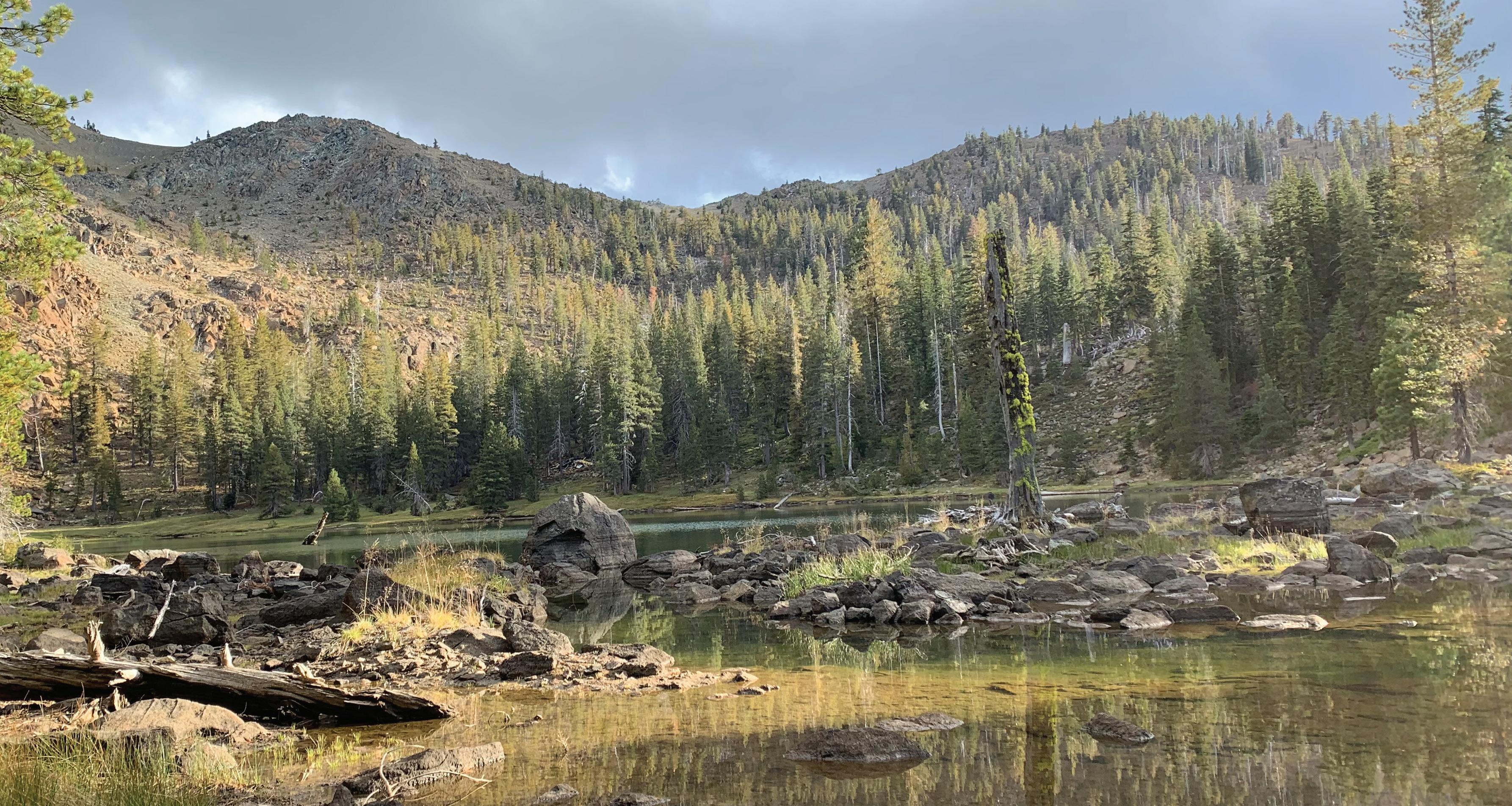
5 minute read
Secret Places
Secret Lake Spot. Photo by Claire Tenscher.
by Claire Tenscher
Because of the Covid crisis, I’ve had the opportunity to live and work from my hometown in the mountains of northern California. I can hike from my door; the house backs up on national forest land and wilderness, crossed only by the PCT. Within a short drive dozens of lakes are accessible by hundreds of miles of trails, and there are rafting, mountaineering, and mountain biking areas surrounding the town.
It turns out that I’m not the only one suddenly liberated. While the pandemic and associated economic crisis have put millions of our friends and family out of work, they have also given many people the freedom to enjoy summer like never before. The natural features that drew me home have also lured thousands of tourists to the area and turned this summer into the busiest we can remember.
This means that easy or well publicized hikes that were serene before are now crowded. The riverside spots we’d usually go for a quick swim after work are occupied by campers, and litter and trash dumping have become a public health hazard around our drive-in lakes. A friend reports encountering a large group with a drone, stereo system, and an inflatable structure at a hike-in lake in a USFS wilderness area. While I will admit the idea of a floating castle at a remote lake does appeal to me, drones and music are both poor etiquette and illegal, as is the trash dumping.
Assuming good intent, some people just aren’t aware of their impact on the land or others, and that has made for a worse experience for those of us who place our faith in the 1964 federal Wilderness Act:
“A wilderness, in contrast with those areas where man and his works dominate the landscape, is hereby recognized as an area where the earth and its community of life are untrammeled by man, where man himself is a visitor who does not remain. …retaining its primeval character and influence …which (1) generally appears to have been affected primarily by the forces of nature, with the imprint of man’s work substantially unnoticeable; (2) has outstanding opportunities for solitude or a primitive and unconfined type of recreation …”
Crowded hikes in my region would be considered positively desolate compared to most in the Gorge or on Mt. Hood. Nevertheless, my desire to avoid people has driven me to explore spots that I’ve heard about for years but never visited. I’ve used the Gaia GPS app more this summer than in the past five years.
I visited a 25 foot waterfall, a five miles hike from my house, with a swimming hole and no official trail. A 15-minute drive away, a 3,000-vertical-foot, five-mile trail leads to two perfect alpine lakes that I’ve seen on maps for a decade and never visited. They’re now lodged in my heart for their perfect combination of isolation, easy access, and swimability. A friend and I hiked to a cedar of record-setting diameter. We followed a faint, cairned trail there,
then created a loop past a historic cabin site, over several ridges, and by some lovely vistas. We encountered no one else, even the trailhead was empty.
There’s inherent tension between wanting the outdoors to be more accessible and more diverse, and wanting a solitary wilderness experience. What gives me the right to dictate the ‘correct’ way to enjoy nature? Is the wilderness experience that I desire exclusionary? Are my wilderness ethics driven by cultural background? Because I grew up here, I have access to areas that others do not. Those alpine lakes I discovered are nestled in the steep ridges of a 9,000’ foot peak to one side, and private property on the other. The land has been acquired to build a trail through public property to these lakes, but the easiest access requires knowing the right people.
How many of us have tried to get a permit for the Enchantments or to climb St. Helens and missed out? It would be a tragedy if all our wild places were limited like this, but there is only so much use the land can take and still maintain its primeval character. I’ve often found that just beyond the most popular destinations, or between two remote places, trails become suddenly lonesome and overgrown. Encouraging people to look beyond the most publicized places could help alleviate pressure across the trail network. Enjoying less-dramatic vistas, looking for simpler beauty, should be celebrated.
As I write this, the idea of secret spots and hidden lakes is moot. All the forests in California are fully closed to recreators because of the supremely dry conditions causing terrible fires up and down the West Coast. Even if the forests weren’t closed, the smoke would probably keep us indoors. Forest Service gates normally closed only due to snow conditions are shut now. A fire threatens the ancient grove of trees where that record cedar resides. My heart sinks when I think of fires’ effect on the places I love, of the loss of hundred year old trees and forests that will not regrow in my lifetime. There’s also the damage to trails: on a recent hike we had to climb or step over more than 120 trees downed by a fire several years ago.
I’m mindful that the green vistas I value are impermanent. Forests are constantly changing, mountains become hills, and lakes become meadows. The two beautiful lakes near my home demonstrate this perfectly. The lower lake is long and deep, shadowy logs can be seen in the cold, clear water below as you swim. The upper lake is a shallow pool. It turns into a cheerful, tadpole-filled creek as it flows through its former basin, now a broad grassy meadow.








